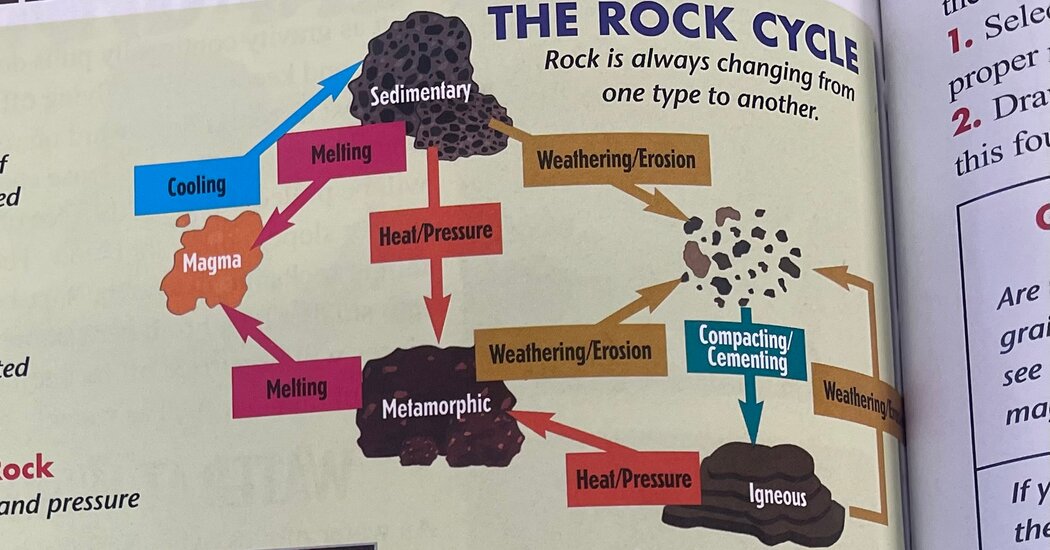E.P.A Lab Helps Plan the Fastest Road to an EV Future
Inside a secretive government laboratory, behind a tall fence and armed guards, a team of engineers has been dissecting the innards of the newest all-electric vehicles with a singular goal: Rewrite tailpipe pollution rules to speed up the nation’s transition to electric cars.
On Wednesday, the Environmental Protection Agency is expected to propose ambitious greenhouse gas emission standards for cars that are so stringent, they’re designed to ensure that two-thirds of the new vehicles sold in the United States are all-electric by 2032, up from just 5.8 percent today. And the rules could put the nation on track to end sales of new gasoline-powered cars as soon as 2035.
Transportation is the largest source of the greenhouse gases generated by the United States and scientists say that slashing pollution from tailpipes — fast — is essential to averting the most catastrophic impacts of global warming.
But that would also require overcoming myriad technical and logistical challenges: electric vehicles are still too expensive for most consumers, in part because of snarled global supply chains for the materials to build them. The cars also need a national network of millions of easy-to-use fast-charging stations.
The work taking place in the E.P.A.’s automotive research laboratory puts it at the center of one the most complex balancing acts faced by President Biden. He has pledged to fight climate change, and gas-burning cars are a major source of planet-warming pollution. But automobile manufacturing is one of the nation’s most important industries, and a rapid switch to electric vehicles, which require less labor to manufacture, has the potential to displace thousands of auto workers, an important constituency for Mr. Biden.
“This is the biggest transformation that the auto industry has ever seen, as it moves from 100 years of tailpipe pollution to electric vehicles —- and an entirely new way to drive,” said David Haugen, director of the E.P.A.’s National Fuel and Vehicle Emissions Laboratory.
“Any one thing can keep it from happening,” he said, acknowledging the challenges of building charging stations, creating domestic supply chains, and bringing down prices. “Any of those things can make the adoption a struggle. All the pieces have to be there.”
Testing limits
But to do that, experts at the E.P.A. laboratory have to first determine how much electric vehicle technology is likely to advance in the next decade, to help the agency set the strongest tailpipe emissions limits that are still achievable.
To that end, government experts in technology, chemistry, toxicology and law at the lab have been working with engineers from the world’s biggest car companies. They’ve been taking apart and testing the innards of new and not-yet-on-the-market Teslas, GMs, Volkswagens and Nissans to figure out which existing technology can go the farthest and fastest; which is the sturdiest and most durable; and which is equipped with the most affordable technology. Different models have different strengths — no single make possesses every component of an affordable, muscular, family-friendly, wide-ranging electric vehicle, researchers said.
They’ve driven electric cars on giant treadmills continuously, in 12-hour shifts, to see how many miles they can travel on a single charge. They’ve heated the cars to nearly 100 degrees and then frozen them overnight to assess battery strength. They’ve run hours and hours of computer simulations.
“Observing these technologies gives us a lot of confidence that this can happen,” said Mr. Haugen. “This regulation will help all the automakers move at the fastest pace they possibly can so that we can address climate change with the urgency it deserves.”
‘We’ve never seen anything like what’s coming now’
One factor weighing heavily on the administration is the effect the new tailpipe limits could have on jobs, like those at Ford’s century-old Rouge manufacturing complex, about 40 miles east of the E.P.A. laboratory.
There, autoworkers and their union leaders worry about what the coming regulation means for their future. They have good reason: electric vehicles require fewer than half the number of workers to assemble than cars with internal combustion engines.
“We know we will lose jobs through this at some point,” said Mark DePaoli, a vice president of the United Auto Workers Local 600, in a recent interview at the local’s headquarters near the Ford plant in Dearborn.
To understand what’s at stake, compare the chassis of the Ford F-150 pickup truck — the top-selling passenger vehicle in the United States — with its all-electric version, both built at the Rouge complex. The gas-powered F-150 is composed of thousands of small metal parts and pieces and is assembled by 4,200 employees in the conventional truck plant. The all-electric Ford F-150 is essentially a giant battery attached to motors and wheels that is built by about 720 workers next door, at the Rouge Electric Vehicle Center.
As the transition from gasoline-powered to all-electric speeds up, one of the roughly 150,000 unionized auto jobs nationwide that could be lost might belong to Steve Noffke, who has built internal combustion engines for Ford for 25 years.
“I’m not opposed to electric vehicles, don’t get me wrong,” Mr. Noffke, 69, said. “If this transition is going to take place, we understand that; most of us have been through transitions before. But we as workers shouldn’t have to pay for it.”
Mr. Noffke noted that his industry has seen plenty of disruption to this point. The 1994 North American Free Trade Agreement sent thousands of auto manufacturing jobs to Mexico. The 2008 financial crisis pushed automakers to the brink of collapse. Advances in automation continue to replace people with robots.
In Dearborn, scars from some of that dislocation are still evident in empty factories, an abandoned Payless Shoes store, a boarded-up Brown’s Bun Bakery.
But the changes being wrought by electric vehicles are significantly more jarring, Mr. Noffke said. “We’ve never seen anything like what’s coming now,” he said.
Angela Powell, 46, who drives a forklift in Ford’s electric vehicle assembly plant, could emerge as one of the winners in the new automotive landscape.
“To come from the old building and see the new vehicles, the state-of-the-art technology, it’s amazing,” said Ms. Powell, who previously worked on the assembly line in Ford’s conventional truck plant. “Who would have ever thought we would be here at this point? It’s an exciting time.”
Still, Ms. Powell worries about what will happen if the change is not managed well. If the government tries to effectively end the sale of new gasoline-powered cars by 2035, what happens if consumers don’t buy electric vehicles? What if they’re too expensive, or there aren’t enough charging stations, or supply chain disruptions slow down production?
“If this thing doesn’t go over right, will I have a job to come into the next day?” she said.
Another concern is that many of the new electric vehicle factories and battery plants are opening in Southeastern states like Georgia, Alabama and Tennessee, where the political culture is historically hostile to organized labor, and wages and benefits are typically lower than in unionized plants.
“If you go to one of these start-ups, or even a Ford plant where that isn’t a union job, you’re going to be making big sacrifices economically,” Mr. Noffke said.
A self-described “car guy,” Mr. Biden enjoys visiting automobile factories, including the Ford plant where Ms. Powell works and where Mr. Biden took the electric F-150 for a spin and declared: “This sucker’s quick.”
Mr. Biden revels equally in his relationship with organized labor, calling himself more pro-union than his predecessors. That connection to autoworkers helped Mr. Biden carry Michigan in 2020, after the state had supported Donald J. Trump in 2016. Labor’s support will be crucial if Mr. Biden runs again in 2024.
Now, Mr. Biden is trying to maintain his standing with union workers at the same time he acts on climate change, an issue he has called a top priority. He has promised to cut the United States’ greenhouse gas pollution at least 50 percent by 2030.
A 2021 report by the International Energy Agency found that nations would have to stop selling new gasoline-powered cars by 2035 to keep average global temperatures from increasing 1.5 degrees Celsius (2.7 degrees Fahrenheit) compared with preindustrial levels. Beyond that point, scientists say, the effects of catastrophic heat waves, flooding, drought, crop failures and species extinction become significantly harder for humanity to handle. The planet has already warmed an average of about 1.1 degrees Celsius.
“There’s a vision of the future that is now beginning to happen, a future of the automobile industry that is electric — battery electric, plug-in hybrid electric, fuel cell electric,” Mr. Biden said in 2021 as he announced an executive order calling for federal policies to ensure that half of new cars sold were all-electric by 2030.
The Inflation Reduction Act of 2022 provides up to $7,500 in tax credits for buyers of electric vehicles. But incentives alone won’t be enough to meet the president’s climate targets, which is why new E.P.A. regulations are needed, experts said.
“Nothing else ensures the transition to EVs at the pace we need to address global warming,” said Drew Kodjak, executive director of the International Council on Clean Transportation, a research organization.
California, home to the nation’s largest auto market, has already passed a ban on the sale of new internal combustion engine vehicles after 2035. Several officials working on the new federal regulation did similar climate work in California.
But despite Mr. Biden’s commitment, a transition to an all-electric future carries political and economic risks.
Representative Debbie Dingell, a Michigan Democrat whose district includes more than a dozen auto assembly plants as well as the E.P.A. automotive lab, frequently reminds Ali Zaidi, a senior White House climate adviser, of the complexity of the situation.
Mr. Zaidi speaks to Ms. Dingell so often, she is listed as simply “DD” in his cellphone.
“I’ve had real heart-to-heart conversations with the president and he does understand what these workers are afraid of,” said Ms. Dingell, a former executive for General Motors. “We have to make sure the policy underpinnings to be able to achieve something like this are there, without hurting people.”
Mr. Biden has worked to ensure that only American-made electric vehicles would qualify for tax incentives provided by the Inflation Reduction Act — although a requirement that they must be assembled by union workers was dropped.
In 2022, Mr. Biden signed another law providing subsidies to companies to make their electric vehicle semiconductor chips in the United States. And in 2021, he signed an infrastructure law that includes $7.5 billion to build half a million electric vehicle charging stations along federal highways, although a January report from S & P Global concluded that the nation would need millions more.
“There’s too much at stake not to get this right,” Ms. Dingell said. “But it’s a very difficult balance.”


